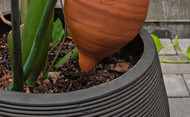For over 4 millennia, farmers practicing traditional methods have successfully used clay pots, or ollas, to irrigate crops in drought-prone environments. This ancient technology is now in the spotlight as permaculture practitioners, agronomists, home gardeners and hobbyists are re-discovering the ecological benefits of this simple yet effective subterranean water conserving irrigation system.

Japanese Garden Tools Vs. American: What’s the Difference?
You may have seen Japanese gardening tools popping up more in stores and online. Sure, they&rs… Read More


